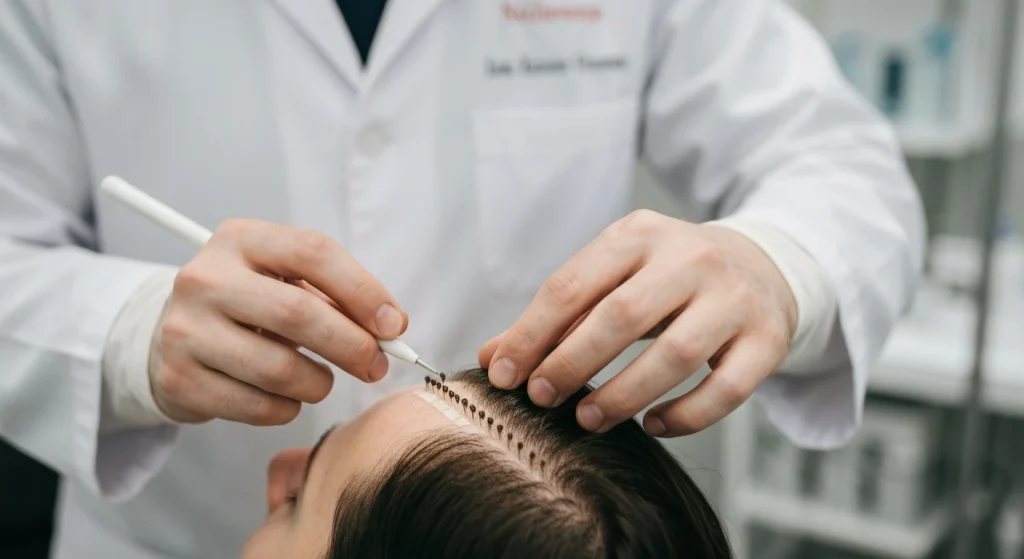Congratulations on your decision to undergo a hair transplant! While the surgical procedure is the first step toward restoring your hair, long-term success critically depends on post-operative care. The survival of the grafts (transplanted hair follicles) and achieving a natural result require strict adherence to instructions.
This comprehensive guide will accompany you step-by-step throughout the recovery process, from the first day until the final results appear.
Phase 1: The Critical First Weeks
Days 0–2: Immediately After the Operation
These are the most delicate 48 hours, where the new grafts are most fragile.
- Do not touch the transplanted area: Strictly avoid any contact, rubbing, or scratching. This is the most important rule!
- Hydration and Nutrition: After leaving the clinic, consume light food and drink plenty of fluids (water, fruit juices). Avoid carbonated drinks and caffeine.
- Medication: Follow the doctor’s prescription and instructions precisely to manage pain and prevent infections.
- Head Position: Keep your head upright, especially when using your phone, to minimize swelling in the forehead area.
- Sleeping: Sleep on your back and use 2-3 pillows to keep your head elevated. This helps reduce swelling and prevents accidental contact with the transplanted area.
- Absolute Rest: Do not perform any physical activity. Relax and allow your body to recover.
- Prohibited Substances: Smoking, alcohol, coffee, and energy drinks are strictly forbidden as they negatively affect blood circulation and graft healing.
Days 2–7: The First Wash and Gentle Care
- Washing your hair: The first wash should be done after 48-72 hours, as recommended by the clinic. Use the advised hydrating solution. Apply it gently with your fingertips (without rubbing), leave it on for 20 minutes, and then rinse with lukewarm, low-pressure water.
- Drying: Do not use a towel to rub your head. Dry it gently by dabbing lightly with a clean, soft towel or let it air dry naturally.
- Protection: Avoid wearing hats, hoods, or helmets for at least 7-10 days.
- Physical Activity: Continue to avoid intense physical activities to keep your blood pressure at normal levels.
Weeks 2–4: Scab Removal and Normalization
- Scab Removal: After about 10 days, the crusts (scabs) formed around the grafts will begin to fall off. If they do not fall off on their own, apply the washing solution, leave it on for 45-60 minutes to soften them, and then gently massage with circular motions to help them detach. This procedure can also be performed at our clinic for your safety.
- Shampoo Use: Once all the scabs have been removed, you can start washing your hair normally, but using a gentle, chemical-free shampoo (like baby shampoo), no more than 3 times a week.
- Return to Normalcy: You can start wearing hats, going to the beach, or getting a haircut, but always after consulting with your doctor.
- Physical Activity: You can resume light physical activities after 14 days, gradually increasing the intensity.
Phase 2: The Growth Process and Results
Months 1–3: The “Shock Loss” Phase and Supportive Treatments
- Temporary Shedding (Shock Loss): Do not be alarmed if the transplanted hair begins to fall out during the first month. This is a completely normal phase called “shock loss.” The hair roots remain secure under the skin and will begin to produce new hairs after the third month.
- Supportive Treatments (PRP): This is the ideal time to start PRP (Platelet-Rich Plasma) sessions to stimulate and strengthen the new follicles. Our standard plan includes 6 sessions:
- The first 3 sessions: Every week.
- The next 3 sessions: Every month.For patients who cannot come to the clinic, the doctor will recommend an alternative treatment with medication.
Months 4–6: The Beginning of New Growth
- New Hair Growth: During this period, you will begin to notice the first new hairs. Initially, they may be thin and light, but they will gradually become thicker and stronger.
- First Visible Results: After 6 months, about 50-60% of the final result will be visible.
Months 12–14: The Final Result
- Final Outcome: To see the final density and appearance of your new hair, you need to wait 12 to 14 months. At this point, the hair will have reached its maximum length and thickness.
- Long-Term Care: Continue to protect your hair and scalp from strong sun and harsh chemicals to maintain their health.
Conclusion: Our Shared Journey with You
The success of a hair transplant is a partnership between the expertise of the medical team and your dedication to post-operative care. By rigorously following these guidelines, you maximize the chances for an excellent, natural, and lasting result.
Remember, this is a shared journey. For every step of the process, we will be by your side to support you.
Frequently Asked Questions (FAQ)
1. When can I wear a hat after a hair transplant?
It is recommended to wait at least 7-10 days, after all the scabs have fallen off, and to choose a loose-fitting hat that does not put pressure on the transplanted area.
2. Is hair shedding (shock loss) normal?
Yes, absolutely. “Shock loss” is a normal phase where the transplanted hair shafts fall out, but the roots remain active. New growth typically begins after the third month.
3. When will I see the final results?
Initial results become visible after 6 months, while the final result and maximum density are achieved after 12-14 months.
4. Can I smoke or drink alcohol after the procedure?
No. Smoking and alcohol should be avoided for at least the first week, as they negatively affect blood circulation and delay the healing process.
By choosing International Hair Clinic, you are not just choosing a procedure, but a dedicated partner for restoring your hair and your confidence.

